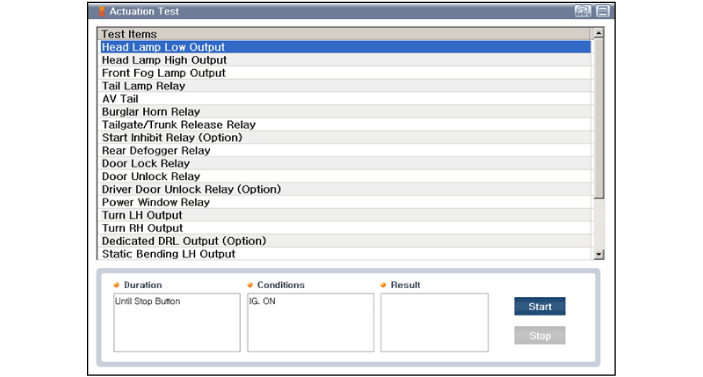Hyundai Ioniq: Fuses And Relays / Relay Box (Passenger Compartment). Repair procedures
Hyundai Ioniq (AE) 2017-2025 Service Manual / Body Electrical System / Fuses And Relays / Relay Box (Passenger Compartment). Repair procedures
| Fuse Inspection |
| 1. | Be sure there is no play in the fuse holders, and that the fuses are held securely. |
| 2. | Are the fuse capacities for each circuit correct? |
| 3. | Are there any blown fuses?
|
| Diagnosis with GDS |
| 1. | The body electrocal system can be quickly diagnosed failed parts with vehicle diagnostic system (GDS). The diagnostic system (GDS) provides the following information.
|
| 2. | Select the "Car Model" and the system to be checked in order to check the vehicle with the tester. |
| 3. | Select the "Smart Junction Block (SJB)". |
| 4. | Select the "Current Data" menu to search the current state of the input/output data. The input/output data for the sensors corresponding to the Smart Junction Block (SJB) can be checked.
|
| 5. | If you will check the power door lock operation forcefully, select "Actuation Test".
|
| 6. | If you want to change user option, select "User Option".
|
| Removal |
| 1. | Disconnect the negative (-) battery terminal. |
| 2. | Remove the crash pad lower panel. (Refer to Body - "Crash Pad Lower Panel") |
| 3. | Disconnect the connectors (A) from the fuse side of the SJB.
|
| 4. | Remove the SJB (A) after loosening the mounting nuts.
|
| 5. | Disconnect the connectors from the back side of the SJB.
|
| Installation |
| 1. | Install the smart junction box. |
| 2. | Install the crash pad lower panel. |
| 3. | Connect the negative (-) battery terminal. |
| 4. | Check that all system operates normally. |
 Relay Box (Passenger Compartment). Description and operation
Relay Box (Passenger Compartment). Description and operation
DescriptionAuto Cut System of Dark Current Abbreviation Expalnation AAFActive Air FlapACUAirbag Control UnitAEBAutonomous Emergency BrakingAHBActive Hybrid Brake SystemAMPAmplifierAVNHead Unit (Audio / AVN)B_CANBody Controller Area NetworkBCMBody Control ModuleBMSBattery Management SystemBSDBlind Spot DetectionC_CANChassis Controller Area NetworkCARMERARear View CarmeraCLUCluster ModuleDATCDual Automatic Temp ControlFPCMFuel Pump Control ModuleHPCUHybrid Power UnitIGPMIntergrated Gateway & Power control ModuleLDWSLane Departure Warning SystemM_CANMulti media Controller Area NetworkMDPSMotor Driven Power SteeringP_CANPowertrain Controller Area NetworkPASParking Assist SystemSJBSmart Junction BlockSMKSmart Key UnitTCM(DCT)Double Clutch Transmission UnitVESSVirtual Engine Sound SystemSmart Junction Block (SJB) General function : Interior Junction Block + some functions of BCMIt controls loads with CAN communication and IPS...
Other information:
Hyundai Ioniq (AE) 2017-2025 Service Manual: Rear Seat Cushion Cover. Components and components location
C..
Hyundai Ioniq (AE) 2017-2025 Service Manual: Shift Cable. Repair procedures
Removal • Be sure to read and follow the "General Safety Information and Caution" before doing any work related with the high voltage system. Failure to follow the safety instructions may result in serious electrical injuries...
Categories
- Manuals Home
- 1st Generation Ioniq Owners Manual
- 1st Generation Ioniq Service Manual
- How to Disconnect Normal Charger
- Washer Fluid
- If the 12 Volt Battery is Discharged (Hybrid Vehicle)
- New on site
- Most important about car
Hybrid Vehicle Interior Overview

1. Door lock/unlock button
2. Driver position memory system
3. Side view mirror control switch
4. Central door lock switch
Copyright © 2025 www.hioniqae.com









